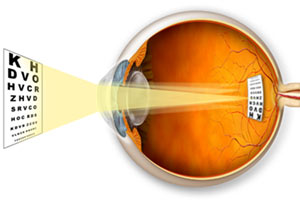Astigmatism
Astigmatism is a refractive error where people are unable to see objects clearly up close or from a distance. Astigmatism may occur in varying degrees in each eye and can accompany myopia or hyperopia. A minor degree of astigmatism is usually not noticeable or comes with slight blurriness but a major ' degree of astigmatism causes blurriness for objects at any distance.
It may accompany nearsightedness or farsightedness. Usually it is caused by an irregularly shaped cornea (called corneal astigmatism). But sometimes it is the result of an irregularly shaped lens, which is located behind the cornea; this is called lenticular astigmatism. Either kind of astigmatism can usually be corrected with eyeglasses, contact lenses or refractive surgery.
Astigmatism Symptoms and Signs
 |
| Astigmatism (also referred to as Refractive Error) |
A minor degree of astigmatism is usually not noticeable or comes with slight blurriness but a major degree of astigmatism causes blurriness for objects at any distance.
What Causes Astigmatism?
Astigmatism is caused by an irregular shape of the cornea. In astigmatism, the cornea is shaped more like a football, an oval shape, than the normal round shape like a baseball. This irregular shape causes two images to be focused. A slight amount of astigmatism is normal and does not require correction. Astigmatism is usually present since birth and generally worsens as we age.
Treatment for Astigmatism
People with Astigmatism have blurred vision of varying degrees. Treatment for astigmatism includes eyeglasses, special contacts, and certain refractive surgeries. |





